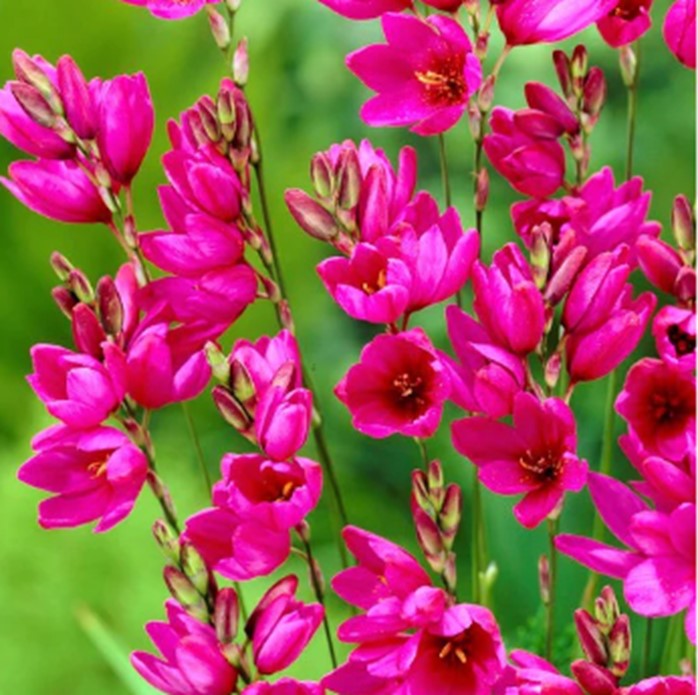African corn lilies, also known as Ixia, are absolutely gorgeous flowering plants that can add a real pop of color to any garden with their vibrant blooms However, like any plant, African corn lilies can fall victim to various diseases that can impact their health and beauty By learning how to spot these common diseases and using proper treatment methods, you can help your African corn lilies continue to thrive and flourish in your garden.
Powdery Mildew
One of the most widespread diseases that affects African corn lilies is powdery mildew. This shows up as a white powdery coating on the leaves and stems of the plant. It is prompted by fungal spores and thrives in warm humid conditions.
To treat powdery mildew on African corn lilies, it is vital to first prune away any impacted plant parts. Ensure proper air flow around the plants by spacing them appropriately. You can also apply antifungal treatments specifically designed to target powdery mildew to prevent its spread.
Botrytis Blight
Botrytis blight is another very common disease that can impact African corn lilies. Symptoms of botrytis blight include brown spots on the leaves and flowers, as well as a fuzzy gray mold that develops on the affected parts of the plant. This fungal disease flourishes in cool, damp conditions.
To control botrytis blight on African corn lilies, it is essential to remove any infected plant parts right away. Improve air flow around the plants and avoid overhead watering to decrease humidity levels. Applying antifungals can also help control the spread of botrytis blight.
Root Rot
Root rot is a dangerous disease that can affect African corn lilies if they are overwatered or planted in poorly draining soil. Symptoms of root rot include wilting leaves, yellowing foliage, and stunted growth. The roots of the plant may appear dark and mushy when affected by this disease.
To treat root rot in African corn lilies, it is vital to first tackle the underlying cause by enhancing soil drainage and adjusting watering practices. Remove any impacted plants and replant them in fresh soil if needed. Avoid overwatering and ensure that the plants are not sitting in waterlogged conditions.
Leaf Spot
Leaf spot is a very common fungal disease that can impact African corn lilies, prompting small circular spots to form on the leaves. These spots may be yellow, brown, or black in color and can combine to cover larger areas of the foliage.
To control leaf spot on African corn lilies, it is important to remove any infected leaves right away to prevent the spread of the disease. Avoid overhead watering and ensure that the plants have sufficient space for air flow. Applying antifungals can also help manage leaf spot outbreaks.
Virus Diseases
African corn lilies are prone to various virus diseases that can cause stunted growth, distorted foliage, and poor flowering. These diseases are often spread by pests like aphids or through contaminated tools used for pruning.
Preventing virus diseases in African corn lilies requires practicing good garden cleanliness by regularly sanitizing tools used for gardening tasks. Check the plants for signs of viral infection and promptly remove any impacted parts to stop the spread of the disease. Additionally, controlling pest populations can help decrease the risk of virus transmission.
How to Prevent Disease
Prevention is always the best medicine when it comes to African corn lily diseases. Here are some tips:
- Purchase healthy plants or bulbs from reputable sources
- Provide ideal growing conditions – full sun, rich soil, excellent drainage
- Avoid overhead watering to reduce humidity
- Allow space between plants for air circulation
- Clean up and remove garden debris promptly
- Disinfect tools regularly
Treatment Options
If diseases do occur, here are some treatment options:
- Remove and destroy infected plant parts
- Use natural fungicides like neem oil or baking soda solutions
- Apply chemical fungicides according to label instructions
- Improve air flow and reduce watering
- Consider replanting in fresh soil if root rot is present
- Monitor for pests like aphids that can spread viruses
By identifying issues early and taking prompt action, you can get your African corn lilies back to health. But prevention is truly the best approach for avoiding these common diseases in the first place. With proper care and diligence, your African corn lilies will continue to add beauty to your garden for years to come.

What are lily diseases?
Diseases that attack lilies can lead to unsightly flowers or foliage. They may also cause rotting in the bulbs. Lilies may be affected by;
- Lily disease – caused by the fungal leaf pathogen Botrytis elliptica
- Soil-borne fungal pathogens – Fusarium oxysporum f. sp. lilii and Rhizoctonia solani, which affect the bulbs
- Strains of Tulip breaking virus
Symptoms vary, depending on the disease concerned;
- Oval brown spots appear on the leaves, sometimes spreading until most of the leaf is destroyed
How to Identify & Control Common Garden Pests by Leaf Signatures
FAQ
How to treat lily disease?
How do you treat botrytis on lilies?
What is the fungal infection in lilies?
